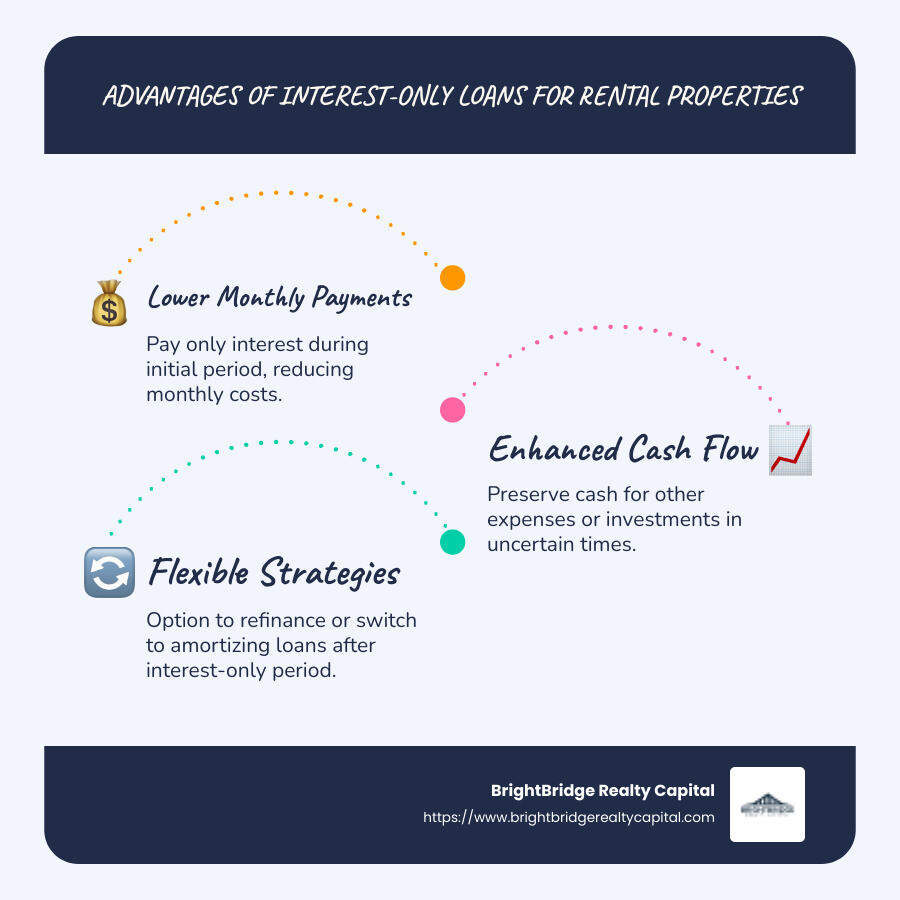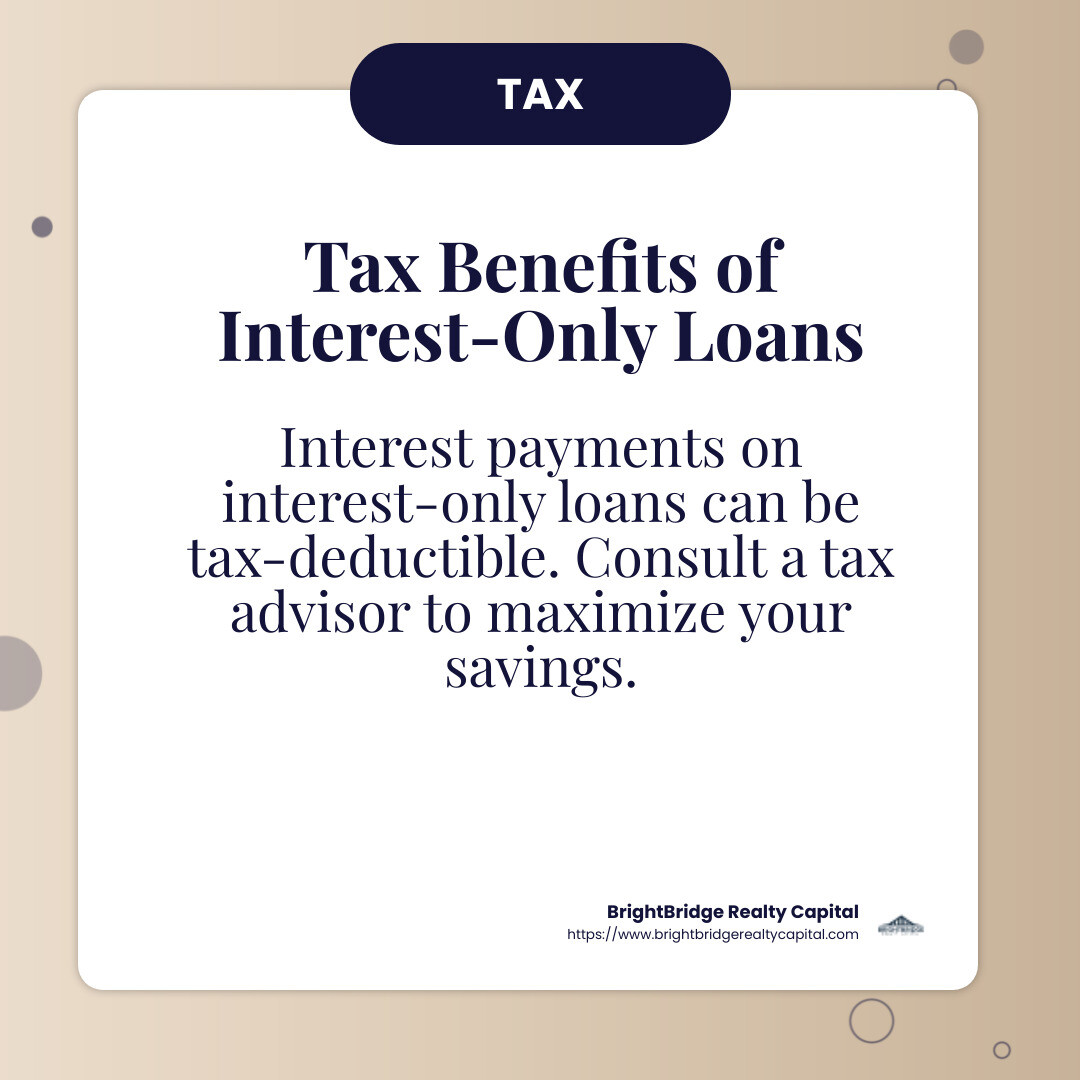Interest-Only Loans: The Key to Unlocking Rental Property Potential

Interest only loan for rental property is a financing option that many real estate investors find invaluable for maximizing cash flow and flexibility. Here's what you need to know right away:
- Lower Monthly Payments: During the interest-only period, you only pay interest, which keeps payments low.
- Cash Flow Boost: Saves cash for repairs or other investments, especially when rental income is uncertain.
- Flexible Loan Strategies: Options to switch to amortizing loans or refinance when the interest-only period ends.
Imagine owning a rental property where each month you pay just the interest on your loan. This frees up cash to handle unexpected expenses or expand your property portfolio. That's the potential power of interest-only loans. They're perfect for real estate investors looking to improve cash flow without the immediate pressure of repaying the principal.
Interest-only loans offer a unique way to manage your rental property finances. But they do come with trade-offs that need careful consideration. As you steer the rental market, weigh the benefits against the risks to ensure smart financial decisions.

Similar topics to interest only loan for rental property:
- creative financing for rental property
- low down payment rental property loans
- refinancing investment property loan
Understanding Interest-Only Loans for Rental Properties
Interest-only loans are a popular choice for those venturing into rental properties. They offer a unique financial structure that can be both beneficial and risky. Let's break down the benefits and drawbacks of these loans to help you make informed decisions.
Benefits of Interest-Only Loans
Lower Monthly Payments
During the interest-only period, you only pay the interest on your loan. This results in significantly lower monthly payments compared to traditional loans, where you pay both interest and principal.
Cash Flow Improvement
With reduced payments, you have more cash available each month. This surplus can be used for property repairs, upgrades, or even to invest in additional properties. Improved cash flow is particularly beneficial when rental income is inconsistent.
Tax Benefits
In some cases, the interest paid on an interest-only loan may be tax-deductible. This can help reduce your overall tax liability, though it's wise to consult a tax professional to understand your specific situation.

Leverage
Interest-only loans allow you to leverage your existing funds more effectively. By lowering your monthly commitments, you might acquire more properties, expanding your portfolio faster.
Drawbacks of Interest-Only Loans
No Equity Build-Up
Since you're only paying interest, you're not reducing the principal balance during the interest-only period. This means you won't build any equity in the property unless its value appreciates.
Repayment Risk
Once the interest-only period ends, you must start repaying the principal, often resulting in much higher monthly payments. Without a solid plan, this can strain your finances or force you to refinance or sell the property.
Higher Interest Rates
Interest-only loans often come with higher interest rates compared to traditional loans. This means you'll pay more over the life of the loan, which can add up significantly.
Property Value Fluctuations
If property values decrease, you could find yourself owing more than the property is worth. This can complicate refinancing or selling the property, especially if the market takes a downturn.
Interest-only loans can be a powerful tool for rental property investors, offering flexibility and cash flow advantages. However, they require careful planning and an understanding of the potential risks involved. Balancing these factors will help you make the most of this financing option as you steer the complexities of real estate investment.
How Interest-Only Loans Work
Interest-only loans offer a unique structure that can be advantageous for rental property investors. Understanding how these loans work is crucial, especially when transitioning from interest-only to amortizing loans.
Transitioning from Interest-Only to Amortizing Loans
Loan Terms and Transition
Interest-only loans typically start with a period where you only pay the interest on the loan. This period can last anywhere from 5 to 10 years. After this, the loan transitions to an amortizing loan, where you begin paying both principal and interest. This transition can lead to significantly higher monthly payments.
Repayment Strategies
To manage the shift from interest-only to amortizing payments, planning is essential. Here are some strategies:
Budgeting for Increased Payments: Anticipate the jump in monthly payments and budget accordingly. This might involve setting aside additional rental income during the interest-only period.
Refinancing Options: Before the transition, consider refinancing the loan. Refinancing might offer better terms, such as a lower interest rate or extended loan term, which can ease the financial burden.
Loan Conversion: Some lenders offer the option to convert the interest-only loan into a fixed-rate amortizing loan. This can provide stability in monthly payments and help with long-term planning.
Refinancing Considerations
Refinancing can be a smart move, but it's important to weigh the costs. Closing costs and fees can add up, so ensure that the benefits of refinancing outweigh these expenses. Additionally, refinancing can reset the loan term, extending the time it takes to pay off the property.
Amortizing Loans
Once the interest-only period ends, the loan becomes fully amortizing. This means your payments will cover both interest and principal, reducing the loan balance over time. This is when you start building equity in the property, an important step for long-term financial health.
Final Thoughts
Transitioning from an interest-only to an amortizing loan requires careful planning and strategy. By understanding your options and preparing for the change, you can maintain financial stability and continue to grow your rental property investments.
Next, we'll explore how interest-only loans compare to traditional loans, focusing on cash flow management and equity building.
Interest-Only Loans vs. Traditional Loans
When deciding between interest-only loans and traditional amortizing loans for rental properties, it's important to understand the key differences. These differences can significantly impact your cash flow, equity building, and overall investment strategy.
Cash Flow Management
Interest-Only Loans:
Lower Monthly Payments: During the interest-only period, you only pay the interest on the loan, which means lower monthly payments. This can free up cash for other investments or unexpected expenses.
Flexibility: The reduced payments offer flexibility, allowing you to reinvest in property improvements or other opportunities that can increase rental income.
Traditional Loans:
- Consistent Payments: With traditional loans, your payments are consistent throughout the loan term. This predictability makes budgeting easier but doesn't provide the same immediate cash flow benefits as an interest-only loan.
Equity Building
Interest-Only Loans:
Delayed Equity: You won't build equity in the property during the interest-only period since you're not reducing the principal balance. This can be a disadvantage if property values decline, potentially leaving you with negative equity.
Equity Building Begins Later: Once the loan transitions to an amortizing structure, you start paying down the principal and building equity, but this process begins later compared to traditional loans.
Traditional Loans:
- Steady Equity Growth: Every payment reduces the principal balance, building equity from day one. This can be advantageous if property values increase, as it allows you to leverage this equity for future investments.
Choosing the Right Loan
The decision between an interest-only loan and a traditional loan depends on your financial goals and risk tolerance.
If cash flow is your priority: Interest-only loans can be a useful tool, especially if you plan to reinvest the savings into other income-generating assets.
If building equity is crucial: Traditional loans offer a steady path to equity growth, providing a buffer against market fluctuations.
Each loan type has its merits and drawbacks. It's essential to assess your investment strategy, financial position, and market conditions before making a decision. Understanding these factors will help you choose the loan that aligns best with your rental property goals.
Next, we'll address some frequently asked questions about interest-only loans, diving into qualifications, tax implications, and potential risks.
Frequently Asked Questions about Interest-Only Loans
What are the qualifications for obtaining an interest-only loan?
To qualify for an interest-only loan for rental property, lenders typically look at several key factors:
Credit Score: A minimum credit score of 620 is often required, but a score of 740 or higher can help you secure better rates and terms.
Financial History: Lenders will examine your financial history, including your income, existing debts, and overall financial stability. A strong financial profile increases your chances of approval.
Debt-to-Income Ratio (DTI): Your DTI is a crucial factor. Lenders prefer a lower ratio, often allowing you to include up to 75% of expected rental income to improve your DTI.
What are the tax implications of interest-only loans?
Interest payments on an interest-only loan are generally tax-deductible, which can provide significant savings. This is a key benefit for real estate investors looking to optimize their tax strategy.
Tax-Deductible Interest: You can deduct the interest paid on the loan from your taxable income, reducing your overall tax liability. This can be particularly advantageous during the interest-only period.
Principal Payments: Unlike interest payments, principal payments are not tax-deductible. It's important to plan for this transition when the loan shifts to an amortizing structure.
What are the risks associated with interest-only loans?
While interest-only loans offer benefits like improved cash flow, they also come with risks:
Property Value Fluctuations: If property values decline, you may face negative equity since you're not reducing the principal during the interest-only period. This can be risky if you need to sell or refinance.
Increased Payments: Once the interest-only period ends, you'll need to start paying both principal and interest. This can lead to significantly higher monthly payments, which may strain your cash flow if not planned for.
Understanding these qualifications, tax implications, and risks can help you make informed decisions when considering an interest-only loan for your rental property.
Conclusion
Navigating real estate financing can be complex, but BrightBridge Realty Capital is here to simplify the process. We specialize in providing customized financing solutions that cater specifically to the needs of real estate investors. Our focus is on delivering quick and flexible funding options, ensuring that your investment strategy remains on track.
One of our standout offerings is the ability to close deals fast—often within a week. This speed is crucial for investors looking to seize opportunities in a competitive market. By eliminating intermediaries, we offer competitive rates and a seamless process that saves you time and money.
Our expertise in interest-only loans for rental properties allows us to help you open up the potential of your investments. With lower initial payments, these loans can improve your cash flow, giving you the flexibility to reinvest in other opportunities or cushion against market fluctuations.
At BrightBridge Realty Capital, we understand that every investor's journey is unique. Our team is dedicated to providing custom solutions that fit your specific goals and objectives. Whether you're looking to grow your rental portfolio or need a strategic financing partner, we are committed to supporting your success.
If you're ready to explore how our interest-only loan options can benefit your rental property investments, connect with us today. Let us help you bridge the gap to smarter real estate financing.


